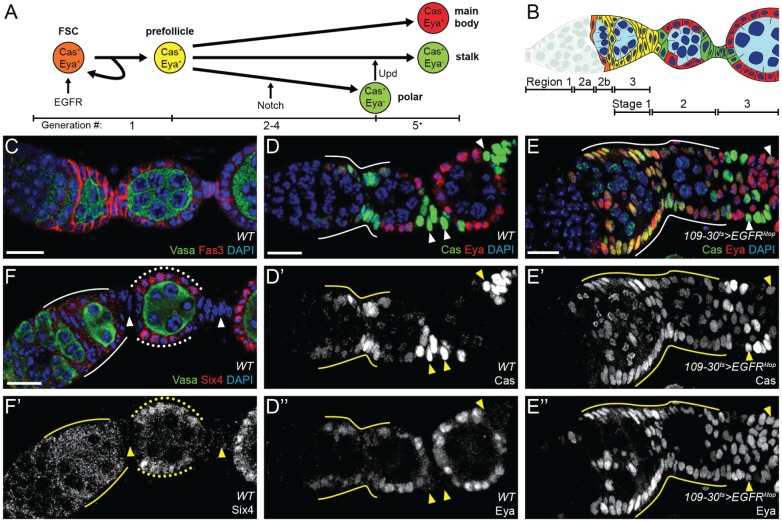Fig. 1.
RNA-seq of follicle cells expressing constitutively active EGFR implicates the transcription factor Six4 in follicle cell differentiation. (A) Map of cell lineages in the follicle epithelium, including some of the known signaling inputs. Numbers at the bottom of the diagram indicate the approximate generation in the FSC lineage of each transition: the FSC division (generation 1) produces a pFC; pFCs divide 1–3 more times (generations 2–4) before committing to the polar cell fate; and differentiation towards the stalk and main body fates occurs over subsequent generations. EGFR promotes FSC self-renewal, Notch promotes the polar fate and Upd promotes the stalk fate. Expression of Cas or Eya is indicated on each cell type. (B) Schematic presentation of a germarium and the most anterior budded follicles, color coded to match the lineages of A. The regions of the germarium and stages of follicle development are indicated below. (C) Morphology of a wild-type germarium. Fas3 (red) staining outlines cell membranes in early follicle cells. Vasa (green) staining marks the germline cysts of the developing follicles. (D) Differentiation status of wild-type follicle cells, as monitored by staining for Cas (green) and Eya (red). Undifferentiated prefollicle cells express both Cas and Eya (solid line), whereas main body cells express only Eya and polar/stalk cells (arrowheads) express only Cas. (E) Follicle cells expressing EGFRλtop show an expansion of follicle cell staining for both Cas and Eya (solid line and arrowheads). D′,E′ and D″,E″ show the Cas and Eya channels, respectively. (F,F′) Six4 staining is uniform in the follicle cells of regions 2b and 3 of the germarium (solid lines), nuclear in the main body follicle cells of budded follicles (dotted lines) and absent from stalk cells (arrowheads). Scale bars: 10 μm. DAPI is in blue.

